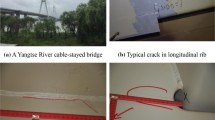Abstract
A reliability assessment method of fatigue life based on the long-term monitoring data is developed for welded details in steel box girder, and the application research is presented with examples of welded rib-to-deck details in Runyang Bridges. Firstly the fatigue damage limit-state function is established based on S-N curves and Miner’s rule, and the probability distribution characteristics of the coefficients in the function are discussed in detail. The uncertainties in fatigue loading effects are mainly studied based on long-term monitoring data. In the traditional studies, only the uncertainty of equivalent stress range is considered in fatigue reliability assessment. However, stress cycle number is also treated as a random variable in this paper because we know traffic flow every day differs in a thousand ways. Then the optimization method is employed to calculate the fatigue reliability. After studying the changing law of the reliability indices with time and the effect of the randomness of stress cycle number on reliability, the effect of the traffic growth on the reliability is studied. This study shows that the uncertainty in the fatigue life of the welded details can be well studied based on structural health monitoring, so it is necessary to carry out long-term strain monitoring of the welded details for accurate fatigue reliability assessment during the whole service period.
Similar content being viewed by others
References
Li Z X, Chan T H T, Ko J M. Fatigue analysis and life prediction of bridges with structural health monitoring data - Part I: Methodology and strategy. Int J Fatigue, 2001, 23: 45–53
Chan T H T, Li Z X, Ko J M. Fatigue analysis and life prediction of bridges with structural health monitoring data - Part II: Application. Int J Fatigue, 2001, 23: 55–64
Guo T, Li A Q, Li J H. Fatigue life prediction of welded joints in orthotropic steel decks considering temperature effect and increasing traffic flow. Struct Health Monit, 2008, 7: 189–202
Zhao Z W, Haldar A, Breen F L. Fatigue-reliability evaluation of steel bridges. J Struct Eng-ASCE, 1994, 120: 1608–1623
Kwon K, Frangopol D M. Bridge fatigue reliability assessment using probability density functions of equivalent stress range based on field monitoring data. Int J Fatigue, 2010, 32: 1221–1232
Cheung M S, Li W C. Probabilistic fatigue and fracture analyses of steel bridges. Struct Saf, 2003, 23: 245–262
American Association of State Highway and Transportation Officials (AASHTO). AASHTO LRFD Bridge Design Specifications. American Association of State Highway Officials, Washington, 1998
BS5400: Part 10. Code of Practice for Fatigue. British Standards Institution, 1982
Frangopol D M, Liu M. Maintenance and management of civil infrastructure based on condition, safety, optimization and life-cycle cost. Struct Infrastruct E, 2007, 3: 29–41
Frangopol D M, Strauss A, Kim S. Bridge reliability assessment based on monitoring. J Bridge Eng, 2008, 13: 258–270
Schilling C G, Klippstein K H, Barson J M, et al. Fatigue of Welded Steel Bridge Members under Variable-Amplitude Loadings. NCHRP Report No. 188, Washington, DC, Transportation Research Board, 1974
Miner M A. Cumulative damage in fatigue. J Appl Mech-T ASME, 1945, 12: 159–164
Ding Y L, Li A Q, Liu T. Environmental variability study on the measured responses of Runyang Cable-stayed Bridge using wavelet packet analysis. Sci China Ser E-Tech Sci, 2008, 51: 517–528
Ding Y L, Deng Y, Li A Q. Study on correlations of modal frequencies and environmental factors for a suspension bridge based on improved neural networks. Sci China Tech Sci, 2010, 53: 2501–2509
Wolchuk R. Lessons from weld cracks in orthotropic decks on three European bridges. J Struct Eng-ASCE, 1990, 116: 75–84
Japan Road Association (JRA). Fatigue Design Specifications for Steel Bridges. Japan Road Association, Tokyo, 2002
BS 7608. Fatigue Design and Assessment of Steel Structures. British Standards Institution, 1993
Guo T, Li A Q, Wang H. Influence of ambient temperature on the fatigue damage of welded bridge decks. Int J Fatigue, 2008, 30: 1092–1102
Downing S D, Socie D F. Simplified rainflow cycle counting algorithms. Int J Fatigue, 1982, 4: 31–40
Wirsching P H. Fatigue reliability for offshore structures. J Struct Eng-ASCE, 1984, 110: 2340–56
Rackwitz R. Reliability analysis-a review and some perspectives. Struct Saf, 2001, 23: 365–395
Rackwitz R, Fiessler B. Structural reliability under combined random load sequence. Comput Struct, 1978, 9: 489–494
Author information
Authors and Affiliations
Corresponding author
Rights and permissions
About this article
Cite this article
Deng, Y., Ding, Y., Li, A. et al. Fatigue reliability assessment for bridge welded details using long-term monitoring data. Sci. China Technol. Sci. 54, 3371–3381 (2011). https://doi.org/10.1007/s11431-011-4526-6
Received:
Accepted:
Published:
Issue Date:
DOI: https://doi.org/10.1007/s11431-011-4526-6




